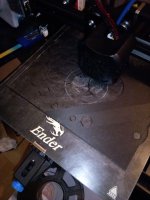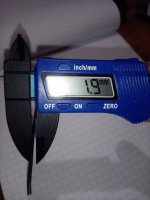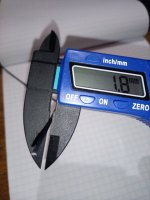nicobie
100 MW
If the nozzle was hitting the bed, you're going to need a new nozzle. The soft brass dents easy closing up the hole. Buy a bunch as they are cheap and I find that they wear out relatively fast.
scianiac said:Pros and cons vs cheap brass nozzles you replace often.
Yep, and figuring in the time it takes to replace, better to just buy a good one. I read that because brass is better at transferring heat that it might be better, but thinking about it, that doesn't really seem to apply. It's handy to toss them if they get clogged, but if everything is set up right you shouldn't be getting clogs.
_GonZo_ said:This are my suggestions for printing strong parts, most of the suggestions are in order to achieve maximum strength and they differ from what is normally used for aesthetic parts. As well there are some suggestions in order to improve parts printing speed.
- Nozzle diameter: 0.6mm to 1mm. (I use normally a 0.8mm)
- Layer height: 40% to 55% of nozzle diameter.
- Line width: 110% to 150% of nozzle diameter. (I use 150% for external perimeters, and around 112% for the other lines)
- Infill pattern: Gyroid. (If sliced in Cura activate “Connect Infill Lines”)
- Printing temperature: As high as the material allows without material degradation.
- Printing speed: Low to medium. (I use 30mm/s for external perimeters, 45mm/s for other perimeters and 65mm/s for infill)
- Use a volcano heating cartridge or similar so maximum volumetric speed can be increased. Test before increase. ( I was able to set it up to 20mm^3/s)
- Use minimum cooling or no cooling at all in order to enhance layer adhesion. (I use auto cooling, it only starts cooling if the layer time is under 30 seconds or at bridges lines)
- Use brass nozzle. (Not if you are using a FG or CF reinforced material)
- Use an enclosure if possible to avoid fast cooling and prevent high internal tensions and warping deformations. (YES even with PLA)
- Set bed temperature to maximum recommended for the material.
- Use some kind of adhesion enhancer in the bed like PVA stick or similar.
I use Sunlu PLA+ it is far more stronger and hit resistant than ABS and far more reliable for outdoor applications (It does NOT biodegradate or affected by UV as much as ABS). It has a softening point a bit higher than normal PLA. It needs to be printed at higher temperature than normal PLA. I recommend it very much for mechanical applications.
i have Sunlu PLA cf,
for strength, would you go 100% infill, connect infill lines, gyroid pattern?
Or get the 3d printer that lays a fiber of kevlar along the print line, making things as strong as aluminum but lighter in weight.
hardened steel nozzle sure messes with the settings,
had to turn nozzle temp to 245
fan down to 60%
speed down to 40 mm/s
otherwise the regular PLA filament would jam
now the feeder doesnt skip at all on the filament




